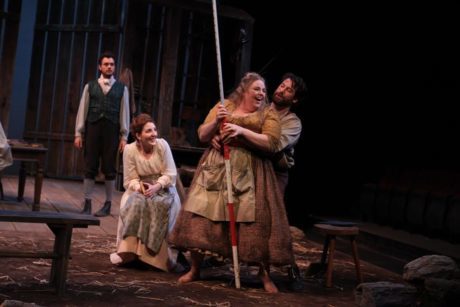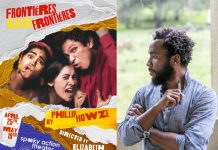In Part 2, Director Valerie Joyce takes us behind the scenes of her production of Translations at Villanova Theatre.
Henrik: Congratulations to the whole Villanova community for having been awarded “a $1 million commitment from the Connelly Foundation to support a new Center for Irish Studies,” which, “Will support Villanova’s ongoing partnership with The Abbey Theatre, Ireland’s National Theatre.” Could you share with us what the plans are for the foreseeable future to foster the study of Irish culture at Villanova?
Valerie: The Connelly Foundation support is such a wonderful boon for the university and the department. So many of our students are already wildly enthusiastic about our connections with the Abbey Theatre through our internship and summer programs that I can’t wait to see what the future holds.
Tell us more about your work at Villanova. You have an impressive background with experience in Early American Theatre, Musical Theatre, Script Analysis, Teaching of Theatre, Theatre for Social Change, and Acting. Tell us how you are juggling these many hats.
Not as efficiently or effectively as I might have over the past month of rehearsals, sadly. But, I have a great passion for each subject and I was trained as a generalist first and foremost, so I feel very fortunate to be at Villanova and to be able to continue to try to juggle all of the hats.
How well did American students and actors, far removed from Ireland physically, but close to cultural divisions in the US, relate to the love story of the Englishman who doesn’t speak Irish, and Máire, who only speaks Irish?

Yolland and Máire’s scene is so well-crafted that even though they have no idea what the other is saying, there is never any confusion about what they are feeling. It is the scene that most audience members comment on after they see the production and one that has been a joy to work on in rehearsal with the students.
In this setting—an American university campus serving both undergraduates and our graduate program—this scene plays with yearning and passion, but also taps into a joy at seeing these characters connect despite their complete lack of verbal communication. The audience’s resulting laughter is the release Friel offers that simultaneously underscores the possibilities and impossibilities of this relationship.
Intercultural and multicultural productions can bring out different responses in audiences, often hinging on their upbringing, cultural conditioning, and their willingness to listen to “the other”—in this case, American and Irish ideologies and ways of expressing oneself.
It has been interesting to me that Irish audience members have sometimes commented that American audiences receive this scene differently than Irish audiences do; that Americans find more humor in the characters’ missed attempts at communication while the Irish appreciate the painful truths beneath the surface of this scene.
In directing Translations, I found that Friel’s use of humor is like threading a needle. His precision is astounding and the humor offers the audience a release of tension while also underscoring a moment or idea he’ll play on later in the text. Most of Jimmy Jack Cassie’s (Barry Brait) humor about Athene in Act 1 sets up the resolution of the play, every bit of Hugh’s acerbic wit and Doalty’s (Kyle Fennie) oafish charm is crafted to build up an energy that is palpable when it is lost, and Maire’s poorly translated “maypoll” line repeats in all three acts, each time within a vastly different world, creating a vastly different impact.
Translations, which explores a wide range of aspects of life, including finding a home in this world, does not offer an easy Walt Disney ending, but leaves it open to thoughts about conquest and impermanence, hopes, and revenge. How did you, as a director, present these complex matters throughout the whole play to both entertain and inform, but also to provoke viewers to think about the linguistic and cultural gulfs in our own lives?
As we worked on the play, we realized that almost every single thing that happens in Act 1 is revisited in Act 3, down to repeated lines, repeated entrances, and repeated props. However, the drastic shift in tone as a result of the action of the plot casts a different light on each event in Act 3 – as if Friel makes promises to the audience and then strips each promise away moment by moment. It is a remarkable structure to watch unfold, from a more clinical stance, and one that accomplishes the sense of impermanence you reference and energizes the emotional journey of the last act.
Once we began to peel that particular onion, there was no stopping it. The more we made of each connection in Act 1, the more resonant each broken promise became in Act 3. Ever since the play was first performed, much of the audience debate around the resolution of the play centers on the apparent lack of specified resolution. I would argue that in refusing to give answers, Friel provokes a consideration of the deeper issues around cultural gulfs in our own lives.

Stephen Matthew Tornetta, Rebecca Jane Cureton, Lize Meisenzahl, and Kyle Fennie in ‘Translations.’ Photo by Paola Nogueras .
Tell us about the artistic team and their shaping Translations. Rumor has it that your landscapers have moved thousands of pounds of soil into the theater and even lugged some boulders onto the stage. It sounds amazing, but is that true?
The rumors are true! The team of Jerold Forsyth (set and lights), John Stovicek (sound), and Janus Stefanowicz (costumes), and Elise D’Avella (dramaturgy) did an absolutely brilliant job of creating a beautiful, detailed, evocative world for us to play in. It wasn’t our landscapers that hauled those rocks, though, it was our graduate set assistants. Their blood, sweat, and blisters are all over these rocks, dirt, and costumes and we deeply appreciate their work.
How does this production show the clash of cultures?
The costumes, by Janus Stefanozwicz, are particularly informative in this moment as Owen, who is dressed with impeccable taste, arrives with the immaculately uniformed Redcoats. The drastic difference between the classes in this entrance makes visible the clash of cultures that is about to unfold. When violence erupts, although Friel leaves it off-stage, the set, lights, and sound designs in our production allow some of the impact to be felt through the open barn door that reflects the desperate act of the Irish, who retaliated against the British by burning their encampment.
The impact Friel focuses on is what will become of the literate and semi-literate people who are left behind in the wake of the struggle. He explores how their heritage is both obliterated and ebbs away like grains of sand, but he remains focused on their integrity and how it remains intact as they learn to adapt and survive and make this new place, this new language their own.
You praised your “spirited ensemble of actors.” What makes them stand out?
They are the nicest group of people to work with [all of the above, including Rebecca Jane Cureton as Sarah and Elizabeth Meisenzahl as Bridget]. We laughed a lot and we had a grand time together. But most of all, they deeply respect the writing and the craft that makes this play both affective and effective. They study script analysis and playwriting and dramaturgy and they enjoy pondering the questions – both great and small. They worked very hard at a very complex dialect and fully invested themselves physically and intellectually. I’m very proud of all of their accomplishments in this production.
Through his famous Translations, Friel said that, “It is not the literal past, the ‘facts’ of history, that shape us, but images of the past embodied in language.” Your production at Villanova did precisely that and allowed us to see invisible realities that shaped life in Ireland, but also life in America. Thank you, Villanova. Go raibh maith agat.
Translations plays through this Sunday, April 24, 2016, at the Vasey Hall Theatre of Villanova University – 800 East Lancaster Avenue, in Villanova, PA. For tickets call (610) 519-7474, or purchase them online.
LINKS:
An interview with Villanova Theatre’s ‘Translations’ Director Valerie Joyce: Part 1: The Irish Chekhov by Henrik Eger.
Neal Newman’s review of ‘Translations’ on DCMetroTheaterArts.




